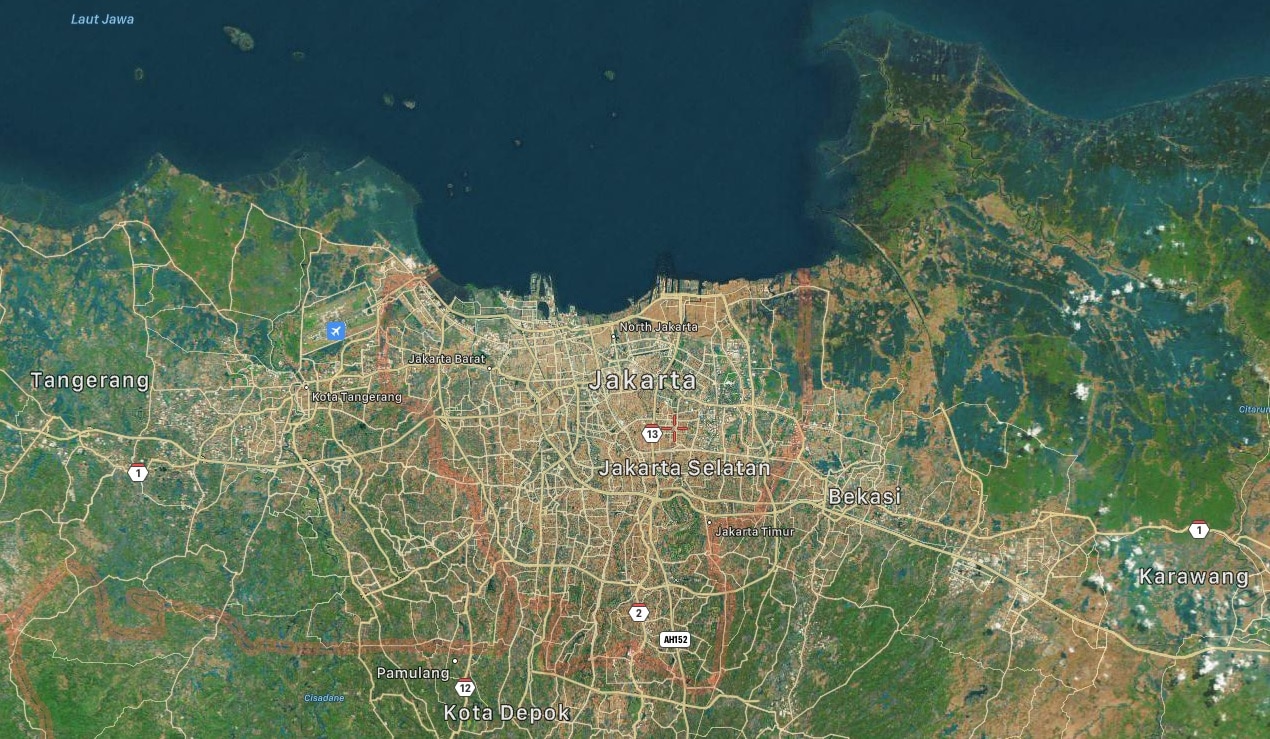Blog
Jakarta: a mega-city faces its climate challenges
Posted 30th August 2020
Introduction
Introduction
2020 has seen a number of floods in Indonesia’s capital, Jakarta, with the worst flood since 2007 occurring on New Year’s Day. This event resulted in over 60 casualties and hundreds of thousands people displaced. [1] Jakarta has been hit by floods numerous times in the past including four events in the last 20 years alone, which could suggest a rising trend. So, what are the causes and contributing factors? The purpose of this article is to provide a brief overview of what is a highly complicated issue.

Figure 1: Jakarta, Indonesia. The map shows areas to the east and west of the city, which have been inundated by seawater and/or flooding during the wet season.[2]
Deforestation and a lack of green spaces
Jakarta is situated in a low-lying downstream area within the Ciliwung River basin running from the mountains and forested areas of West Java and towards the city and coast. Deforestation in West Java has led to an increase in water flow and run-off, and a decrease in water quality (e.g. siltation) since there are not enough trees and forest to absorb excess water after rainfall for natural flood protection and prevention during the rainy season.[3] The benefits of forests and green areas are well known in terms of absorbing excess rainwater more readily.
Rapid Urbanization and Population Growth
The city of Jakarta was built on swampland, which is one of the reasons it is one of the world’s fastest sinking cities (up to 15 cm per annum [4]). Several contributing factors have been identified:
- – Jakarta has a high number of informal settlements, so-called Kampung, which are a direct of result of rapid urbanization. The 1950s saw a lot of construction of infrastructure and the departure of the Dutch with independence that both laid the foundation of mass migration of rural workers into Jakarta in the 1960s causing housing shortages, an insufficient number of schools, medical facilities, and utilities such as sanitation and electricity.

Source: Alzamil, W., (2017). The urban features of informal settlements in Jakarta, Indonesia. Data in Brief. 15, 993-999.
- – The increasing demand for freshwater due to the rapid rise of Jakarta’s population, development of industrial activities, and amid a lack of a water management infrastructure has led to the practice of extracting high volumes of groundwater.[5] This in turn causes subsidence and the ground to sink in localized areas creating catchment areas where water cannot escape in the event of heavy rainfall.
Climate Change and Sea Level Rise
Parts of Jakarta, especially coastal areas lie below sea levels and are therefore susceptible to flooding due to the increase in high tides and cyclonic weather events closely linked to the rise in sea levels and climate change. Coastal stretches in areas such as North Jakarta are currently protected by a sea wall that has failed to be effective. In December 2019 a 170 metre-stretch of the 2.3 km long wall near Muara Baru collapsed; the wall has only recently been installed. In June 2020, panels of the wall also collapsed due to high spring tides and surges caused by cyclonic weather patterns in the wider South-East Asia area. The more or less regular breaches or collapses of seawalls demonstrate that these are only a short-term solution.
In the next articles, we will look at the area around Jakarta and then what the possible solutions might be and what the Indonesian Government could do to relieve the pressure on this sinking city.
About the Author: Tanja Rogers BA (Hons), LLM. Tanja is Company Secretary at International Biodiversity Consultants Ltd and is currently residing in Jakarta, Indonesia (30 August 2020).
About International Biodiversity Consultants Ltd: International Biodiversity Consultants Ltd was formed in 2019 and is focused on global solutions for nature. Find out more here or link up with our social media: linktr.ee/ibioconsultant1
References
[2] See: Apple Maps, 2020; https://satellites.pro/
[3] Other effects of deforestation include a loss in biodiversity and habitats for wildlife, a decrease in water quality, and an increase in droughts during the dry season.
See: http://www.futuredirections.org.au/publication/indonesia-deforestation-puts-jakarta-water-security-risk/
[4] See: Shankar, U., (2019). The lost city of Jakarta? Ecological Economics [online]. [Viewed on 30 August 2020]. https://discuss.leeds.ac.uk/2019/05/07/the-lost-city-of-jakarta/
[5] See for example: Abidin, Z. H., Andreas, H., Gumilar, I., Fukuda, Y., Pohan, Y. E., Deguchi, T., (2011). Land subsidence of Jakarta (Indonesia) and its relation with urban development. Nat Hazards [online]. 59, 1753–1771. [Viewed 19 June 2020]. Available from: doi: 10.1007/s11069-011-9866-9